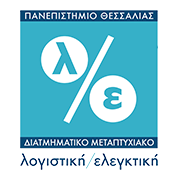Financial Accounting II
- GENERAL
| SCHOOL | SCHOOL OF ECONOMICS AND BUSINESS | ||||
| SECTION | DEPARTMENT OF ECONOMICS AND DEPARTMENT OF ACCOUNTING & FINANCE | ||||
| LEVEL OF STUDIES | POSTGRADUATE LEVEL | ||||
| COURSE CODE | MSC0202 | SEMESTER OF STUDY | 2 | ||
| COURSE TITLE | FINANCIAL ACCOUNTING II | ||||
|
INDEPENDENT TEACHING ACTIVITIES |
WEEKLY TEACHING HOURS | CREDIT UNITS | |||
| LECTURES | 3 | 8 | |||
|
TYPE OF COURSE |
REQUIRED |
||||
| PREREQUISITE COURSES: | NO | ||||
| LANGUAGE OF TEACHING AND
EXAMINATION: |
GREEK / ENGLISH | ||||
| THE COURSE IS OFFERED TO ERASMUS STUDENTS | NO | ||||
| ELECTRONIC COURSE PAGE (URL) | https://eclass.uth.gr/ | ||||
| Upon successful completion of the course, the student will be able to:
• Understand the basic concepts of International Accounting Standards • Understand the usefulness of the different methods of valuation and presentation of financial information based on the main IASs • Applies the most important International Accounting Standards and International Financial Reporting Standards • Prepares financial statements based on IAS |
| Learning Outcomes |
- LEARNING OUTCOMES
| • Search, analysis and synthesis of data and information, using both the
necessary technologies • Decision-making • Autonomous work • Teamwork • Working in an international environment • Working in an interdisciplinary environment • Generating new research ideas • Respect for the natural environment • Demonstrate social, professional and ethical responsibility • Promoting free, creative and inductive thinking |
| General skills |
- COURSE CONTENT
The objective of the International Accounting Standards Theory course is to present and analyse some of the most important International Accounting Standards and International Financial Reporting Standards. Studying the main implications of the application of International Accounting Standards on the financial statements of Greek companies,
the main differences from the Greek Standards and the main innovations introduced in accounting through the application of International Accounting Standards. The standards
these form the basis of the International Financial Reporting Standard for
IFRS for SMEs, as part of the European Commission’s efforts to extend the application of IAS to more companies.
More specifically, during the teaching of the course the following modules will be covered:
- IAS 12 Income Taxes: Determination of income tax and its segregation into
current and deferred
- IAS 17 Leases: Identification of leases and their separation into
financial and operational
- IAS 19 Employee Benefits: defining employee benefits and separating them into five broad categories
- IAS 28 Investments in Associates and Joint Ventures: Defining the concept of
material influence over holdings
- IAS 32 Financial Instruments “Presentation”: principles for separating financial liabilities and equity items
- IAS 33 Earnings per share: determination of earnings per share
- IAS 36 Impairment of Assets: identifying the concept of impairment of assets carried at cost
- IAS 37 Provisions: Defining the concept of provisions
- IAS 39 Financial Assets “Measurement”: definition, definitions and classification of financial assets
- IAS 40 Investment property: Definition and definition of investment property
- IFRS 1 First-time Adoption of IFRSs: determining when an entity first applies IFRSs
which applied a different framework
- IFRS 9 Financial Instruments (not endorsed by the European Union –
replaces IAS 39)
- TEACHING and LEARNING METHODS – EVALUATION
| METHOD OF DELIVERY | On Site & Distance learning – Hybrid room | |||
| USE OF INFORMATION AND COMMUNICATION TECHNOLOGIES | Use of a hybrid room that includes a large
a wall-mounted screen on which the participants are presented remotely. The connection to the course is made through the Microsoft Teams software, in which a camera is connected to the course. in the room is recorded and illustrated by the teacher. The attendance of the course is also done with the use of the Wacom digital pen, which ensures the interactivity of the lesson with notes that appear directly on the students’ screen. In addition, slides are projected, use of the asynchronous education platform for the posting of course materials, students’ assignments and and communication between lecturers and students, search for electronic journals and resources. |
|||
| ORGANISATION OF TEACHING | Activity | Semester workload | ||
| Lectures | 36 | |||
| Study, preparation and presentation of activities |
146 |
|||
| Study and analysis of the literature
(preparation of lectures & exams) |
55 |
|||
| Final written examination | 3 | |||
| Total Course |
240 |
|||
| STUDENT ASSESSMENT | The assessment is carried out in Greek or in English and is based on the preparation of an assignment related to the application of IAS (20%) and the final written examination (80%).
at the end of the semester. |
|||
- RECOMMENDED-BIBLIOGRAPHY
| – Suggested Bibliography:
– Elliott, B. and J. Elliott, “Financial Accounting and Reporting” (12th edition 2008), Pearson Education. |
| – Alexander, D., Britton, A. and Jorisson, A., (2007), ‘International Financial Reporting and
Analysis”, Thompson Learning – Dimitrios Gikas, Afroditi Papadaki, “Financial Accounting” 2012, Publications Benu. – Demosthenes Hevas & Apostolos Ballas “Financial Accounting”, 2008, Benou Publications. – Grant Thornton, “International Financial Reporting Standards”, Grant Thornton, 3rd edition, 2009 |
You may also like
Research Methodology II
GENERAL SCHOOL SCHOOL OF ECONOMICS AND BUSINESS DEPARTMENT DEPARTMENT OF ECONOMICS AND DEPARTMENT OF ACCOUNTING AND FINANCE LEVEL OF STUDIES POSTGRADUATE LEVEL COURSE CODE ΠΜΣ0208 SEMESTER OF STUDY 2 COURSE …
Financial Analysis II
GENERAL SCHOOL SCHOOL OF ECONOMICS AND BUSINESS DEPARTMENT DEPARTMENT OF ECONOMICS AND DEPARTMENT OF ACCOUNTING & FINANCE LEVEL OF STUDIES POSTGRADUATE LEVEL COURSE CODE MSC0201 SEMESTER OF STUDY 2 COURSE …
Management Accounting I
GENERAL SCHOOL SCHOOL OF ECONOMICS AND BUSINESS SECTION DEPARTMENT OF ECONOMICS AND DEPARTMENT OF ACCOUNTING & FINANCE LEVEL OF STUDIES POSTGRADUATE LEVEL COURSE CODE MSC0103 SEMESTER OF STUDY 2 COURSE …

